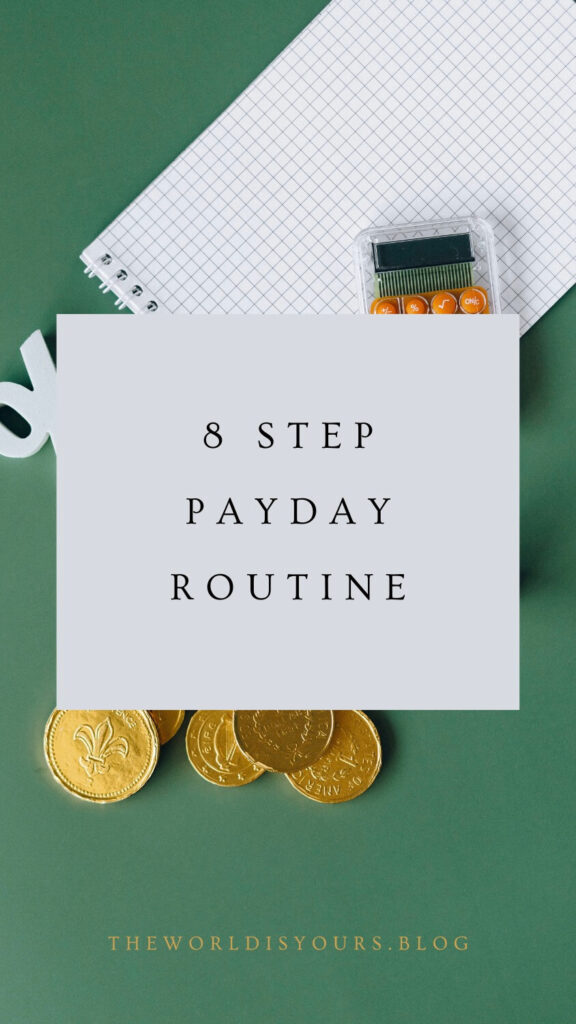In this blog post, I’m going to guide you through 8 essential steps to take control of your payday routine and make your money work for you.
If you’re like most people, payday can be a bit overwhelming. You get a chunk of money, and before you know it, it disappears. I’m here to change that by sharing valuable insights that will help you build a solid financial foundation.
This post may contain affiliate links. This means I may earn a commission if you make a purchase through my links, at no additional cost to you. I only recommend products or services that I personally use and believe will add value to my readers.
Step 1: Know Your Reference Point – The Ostrich Effect
The first step in mastering your payday routine is understanding your financial reference point. Many people tend to avoid uncomfortable financial information, leading to living paycheck to paycheck.
By calculating your essential living expenses and comparing them to your net income, you establish a reference point. Aim to keep this number below 60% of your net income, allowing you to make informed financial decisions.
I like to structure my payday routine with the 50/30/20 rule. 50% of my income goes on needs, these are expenses such as housing, utilities, food and transportation. 30% is for wants, dining out, entertainment etc. The final 20% should be put into savings or investments.
Of course you can rearrange these percentages to suit your lifestyle, you may live well below your means and are able to invest a larger amount of your monthly income each month. This way you will begin to see returns a lot faster.
Step 2: Quick Solution Fund – A Psychological Comfort
Creating an emergency fund is crucial for financial stability. This fund, equivalent to one month’s living expenses, provides peace of mind for unexpected living costs. Saving it in an easily accessible account with high interest ensures financial security without the need for debt in unexpected situations.
For my savings, I exclusively rely on Monzo. They offer monthly payouts of competitive interest rates and provide convenient instant access. If you sign up for Monzo using my link, you’ll receive a £5 bonus.
Step 3: Eliminate High-Interest Debt – Save Money in the Long Run
Paying off high-interest debts should be a priority over saving. Over time, interest can significantly increase the cost of your purchases.
I would recommend listing and prioritising debts with interest rates above 7-8%. Then use your savings to pay them off, considering either the snowball or avalanche method.
Step 4: Sacrifice for Future Pay Increase
While this is not always emphasised in personal finance channels, sacrificing some disposable income for future pay increases is essential.
Incorporating these steps into your payday routine in order is crucial. Prioritise employer-matched retirement contributions only after successfully completing the previous steps.

Step 5: Build an Emergency Fund – A Safety Net
Recently, I’ve been reading Rich Dad Poor Dad, and one idea that caught my attention is how your wealth is determined by how long you can support yourself if you stopped working today.
Similar to step 2, start saving 3 to 6 months’ worth of essential living costs for unexpected life shocks. This emergency fund provides financial security, allowing you to weather challenges like job loss without immediate financial stress.
Step 6: Invest in Yourself – Increase Earning Potential
Invest in your skills and knowledge to boost your earning potential. Whether through a pay raise or a side hustle, the extra income can be directed towards achieving financial goals.
Recently, I came across a video on starting side hustles that match your interests. The video suggested that nearly every hobby or sports activity can be turned into a money-making venture. You could teach others, create a course, or even start a blog or website dedicated to your hobby, just like this one.
Check out my ‘make money‘ section for some ideas and inspiration on how to earn some extra cash each month.
Step 7: Utilise Tax-Free Accounts – Optimise Savings
Make the most of tax-free accounts such as Roth IRAs in the United States or ISAs in the United Kingdom to enhance your savings. Make sure to use all the benefits of employer-matched contributions, and this not only boosts your savings but also helps lower your taxable income.
I personally use Freetrade for my investments. The advantage is that they offer fractional shares, allowing you to begin investing with as little as £2. Sign up using my link to receive a free share valued up to £100.
Step 8: Opportunity Cost – Prioritise Based on Your Vision
Investing additional income comes with an opportunity cost. When you decide to invest extra money, there are alternative opportunities that you forego, known as opportunity cost.
To make the best choice, consider your willingness to take risks, your income level, and your life goals. Whether you choose to pay off your mortgage, delve into private equity, or explore other investments, allocate your money in a way that aligns with your specific objectives and aspirations.
Two ways I accelerated my savings was by resisting impulse purchases and steering clear of unnecessary expenses.

Mastering your payday routine is a journey towards financial success. By following these eight steps, you’ll gain control over your money, build a solid foundation, and create a path towards your financial goals.
Remember, it’s never too early or too late to take charge of your finances and shape the life you envision.
Disclaimer: The content of this blog post is for informational purposes only and does not constitute financial advice. I am not a financial adviser. It is recommended to consult with a certified professional before making any financial decisions or investments.
